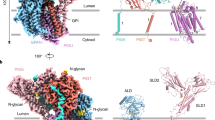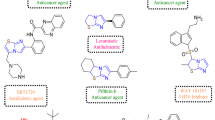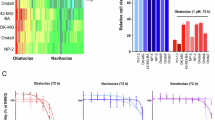Abstract
Autocrine motility factor/ phosphoglucose isomerase (AMF/PGI) promotes cell survival by the pAkt survival pathway. Its receptor, gp78/AMFR, is an E3 ubiquitin ligase implicated in endoplasmic reticulum (ER)-associated protein degradation. We demonstrate here that AMF/PGI also protects against thapsigargin (TG)- and tunicamycin (TUN)-induced ER stress and apoptosis. AMF/PGI protection against the ER stress response is receptor mediated as it is not observed in gp78/AMFR-knockdown HEK293 cells. However, AMF/PGI protection against the ER stress response by TG and TUN was mediated only partially through PI3K/Akt activation. AMF/PGI reduction of the elevation of cytosolic calcium in response to either TG or inositol 1,4,5-trisphosphate receptor activation with ATP was gp78/AMFR-dependent, independent of mitochondrial depolarization and not associated with changes in ER calcium content. These results implicate regulation of ER calcium release in AMF/PGI protection against ER stress and apoptosis. Indeed, sequestration of cytosolic calcium with BAPTA-AM limited the ER stress response. Importantly, elevation of cytosolic calcium upon treatment with the calcium ionophore ionomycin, while not inducing an ER stress response, did prevent AMF/PGI protection against ER stress. By regulating ER calcium release, AMF/PGI interaction with gp78/AMFR therefore protects against ER stress identifying novel roles for these cancer-associated proteins in promoting tumor cell survival.
Similar content being viewed by others
Log in or create a free account to read this content
Gain free access to this article, as well as selected content from this journal and more on nature.com
or
Accession codes
Abbreviations
- AMF/PGI:
-
autocrine motility factor/phosphoglucose isomerase
- AUC:
-
area under the curve
- Ca2+:
-
calcium
- [Ca2+]cyt:
-
cytosolic calcium concentration
- [Ca2+]m:
-
mitochondrial calcium concentration
- [Ca2+]ext:
-
extracellular calcium concentration
- [Ca2+]ER:
-
endoplasmic reticulum calcium concentration
- CCCP:
-
carbonyl cyanide m-chlorophenylhydrazone
- ER:
-
endoplasmic reticulum
- ERAD:
-
ER-associated protein degradation
- FRET:
-
fluorescence resonance energy transfer
- Gp78/AMFR:
-
glycoprotein 78/autocrine motility factor receptor
- IP3R:
-
1, 4, 5-trisphosphate receptors
- SERCA:
-
sarco/endoplasmic reticulum Ca2+-ATPase
- TG:
-
thapsigargin
- TUN:
-
tunicamycin
- UPR:
-
unfolded protein response
References
Ellgaard L, Helenius A . Quality control in the endoplasmic reticulum. Nat Rev Mol Cell Biol 2003; 4: 181–191.
Papp S, Dziak E, Michalak M, Opas M . Is all of the endoplasmic reticulum created equal? The effects of the heterogeneous distribution of endoplasmic reticulum Ca2+-handling proteins. J Cell Biol 2003; 160: 475–479.
Boyce M, Yuan J . Cellular response to endoplasmic reticulum stress: a matter of life or death. Cell Death Differ 2006; 13: 363–373.
Bernales SN, Papa FR, Walter P . Intracellular signaling by the unfolded protein response. Annu Rev Cell Dev Biol 2006; 22: 487–508.
Xu C, Bailly-Maitre B, Reed JC . Endoplasmic reticulum stress: cell life and death decisions. J Clin Invest 2005; 115: 2656–2664.
Moenner M, Pluquet O, Bouchecareilh M, Chevet E . Integrated endoplasmic reticulum stress responses in cancer. Cancer Res 2007; 67: 10631–10634.
Healy SJM, Gorman AM, Mousavi-Shafaei P, Gupta S, Samali A . Targeting the endoplasmic reticulum-stress response as an anticancer strategy. Eur J Pharmacol 2009; 625: 234–246.
Szegezdi E, Logue SE, Gorman AM, Samali A . Mediators of endoplasmic reticulum stress-induced apoptosis. EMBO Rep 2006; 7: 880–885.
Zinszner H, Kuroda M, Wang X, Batchvarova N, Lightfoot RT, Remotti H et al. CHOP is implicated in programmed cell death in response to impaired function of the endoplasmic reticulum. Genes Dev 1998; 12: 982–995.
Hajnoczky G, Csordas G, Das S, Garcia-Perez C, Saotome M, Sinha Roy S et al. Mitochondrial calcium signalling and cell death: approaches for assessing the role of mitochondrial Ca2+ uptake in apoptosis. Cell Calcium 2006; 40: 553–560.
Pinton P, Giorgi C, Siviero R, Zecchini E, Rizzuto R . Calcium and apoptosis: ER-mitochondria Ca2+ transfer in the control of apoptosis. Oncogene 2008; 27: 6407–6418.
Deniaud A, Sharaf el dein O, Maillier E, Poncet D, Kroemer G, Lemaire C et al. Endoplasmic reticulum stress induces calcium-dependent permeability transition, mitochondrial outer membrane permeabilization and apoptosis. Oncogene 2008; 27: 285–299.
Chami M, Oulès B, Szabadkai G, Tacine R, Rizzuto R, Paterlini-Bréchot P . Role of SERCA1 truncated isoform in the proapoptotic calcium transfer from er to mitochondria during ER stress. Mol Cell 2008; 32: 641–651.
Fairbank M, St-Pierre P, Nabi IR . The complex biology of autocrine motility factor/phosphoglucose isomerase (AMF/PGI) and its receptor, the Gp78/AMFR E3 ubiquitin ligase. Mol Biosys 2009; 5: 793–801.
Tsutsumi S, Hogan V, Nabi IR, Raz A . Overexpression of the autocrine motility factor/phosphoglucose isomerase induces transformation and survival of NIH-3T3 fibroblasts. Cancer Res 2003; 63: 242–249.
Wozniak AJ, Ross WE . DNA damage as a basis for 4′-demethylepipodophyllotoxin-9-(4,6-O-ethylidene-beta-D-glucopyranoside) (etoposide) cytotoxicity. Cancer Res 1983; 43: 120–124.
Mandic A, Hansson J, Linder S, Shoshan MC . Cisplatin induces endoplasmic reticulum stress and nucleus-independent apoptotic signaling. J Biol Chem 2003; 278: 9100–9106.
Kojic LD, Joshi B, Lajoie P, Le PU, Leung S, Cox ME et al. Raft-dependent endocytosis of autocrine motility factor is phosphatidylinositol-3-kinase-dependent in breast carcinoma cells. J Biol Chem 2007; 282: 29305–29313.
Kruman II, Mattson MP . Pivotal role of mitochondrial calcium uptake in neural cell apoptosis and necrosis. J Neurochem 1999; 72: 529–540.
Hajnoczky G, Csordas G, Madesh M, Pacher P . Control of apoptosis by IP(3) and ryanodine receptor driven calcium signals. Cell Calcium 2000; 28: 349–363.
Tsokos J, Sans R, Bloom S . Ca2+ uptake by hyperpermeable mouse heart cells: effects of inhibitors of mitochondrial function. Life Sci 1977; 20: 1913–1921.
Palmer AE, Jin C, Reed JC, Tsien RY . Bcl-2-mediated alterations in endoplasmic reticulum Ca2+ analyzed with an improved genetically encoded fluorescent sensor. Proc Natl Acad Sci USA 2004; 101: 17404–17409.
Snapp EL, Sharma A, Lippincott-Schwartz J, Hegde RS . Monitoring chaperone engagement of substrates in the endoplasmic reticulum of live cells. Proc Natl Acad Sci USA 2006; 103: 6536–6541.
Goetz JG, Genty H, St Pierre P, Dang T, Joshi B, Sauv R et al. Reversible interactions between smooth domains of the endoplasmic reticulum and mitochondria are regulated by physiological cytosolic calcium levels. J Cell Sci 2007; 120: 3553–3564.
Haga A, Funasaka T, Niinaka Y, Raz A, Nagase H . Autocrine motility factor signaling induces tumor apoptotic resistance by regulations Apaf-1 and Caspase-9 apoptosome expression. Int J Cancer 2003; 107: 707–714.
Song BL, Sever N, DeBose-Boyd RA . Gp78, a membrane-anchored ubiquitin ligase, associates with Insig-1 and couples sterol-regulated ubiquitination to degradation of HMG CoA reductase. Mol Cell 2005; 19: 829–840.
Fang S, Ferrone M, Yang C, Jensen JP, Tiwari S, Weissman AM . The tumor autocrine motility factor receptor, gp78, is a ubiquitin protein ligase implicated in degradation from the endoplasmic reticulum. Proc Natl Acad Sci USA 2001; 98: 14422–14427.
Goetz JG, Nabi IR . Interaction of the smooth endoplasmic reticulum and mitochondria. Biochem Soc Trans 2006; 340: 370–373.
Joshi B, Li L, Nabi IR . A role for KAI1 in promotion of cell proliferation and mammary gland hyperplasia by the gp78 ubiquitin ligase. J Biol Chem 2010; 285: 8830–8839.
Manning BD, Cantley LC . AKT/PKB signaling: navigating downstream. Cell 2007; 129: 1261–1274.
Lee YI, Kang-Park S, Do SI, Lee YI . The hepatitis B virus-X protein activates a phosphatidylinositol 3-kinase-dependent survival signaling cascade. J Biol Chem 2001; 276: 16969–16977.
Wang H-J, Guay G, Pogan L, Sauve R, Nabi IR . Calcium regulates the association between mitochondria and a smooth subdomain of the endoplasmic reticulum. J Cell Biol 2000; 150: 1489–1498.
Pacher P, Sharma K, Csordas G, Zhu Y, Hajnoczky G . Uncoupling of ER-mitochondrial calcium communication by transforming growth factor-beta. Am J Physiol Renal Physiol 2008; 295: F1303–F1312.
Bodansky O . Serum phosphohexose isomerase in cancer II. As an index of tumor growth in metastatic carcinoma of the breast. Cancer 1954; 7: 1200–1226.
Baumann M, Brand K, Giedl J, Hermanck P, Ruf S, Scheele J et al. Significance of serum phosphohexose isomerase in gastrointestinal cancer at different stages. Oncology 1988; 45: 153–158.
Kojic LD, Wiseman SM, Ghaidi F, Joshi B, Nedev HN, Saragovi HU et al. Raft-dependent endocytosis of autocrine motility factor/phosphoglucose isomerase: a potential drug delivery route for tumor cells. PLOS One 2008; 3: e3597.
Nabi IR, Watanabe H, Raz A . Identification of B16-F1 melanoma autocrine motility-like factor receptor. Cancer Res 1990; 50: 409–414.
Trollinger DR, Cascio WE, Lemasters JJ . Mitochondrial calcium transients in adult rabbit cardiac myocytes: inhibition by ruthenium red and artifacts caused by lysosomal loading of Ca(2+)-indicating fluorophores. Biophys J 2000; 79: 39–50.
Luciani DS, Gwiazda KS, Yang TL, Kalynyak TB, Bychkivska Y, Frey MH et al. Roles of IP3R and RyR Ca2+ channels in endoplasmic reticulum stress and beta-cell death. Diabetes 2009; 58: 422–432.
Acknowledgements
We thank Dr Dan Luciani (UBC) for advice concerning the ER Ca2+ measurements. This study was supported by a grant from the Canadian Institutes for Health Research (CIHR MT-15132). LL is the recipient of a UBC Four Year Doctoral Fellowship; TA was supported by the Karl Heinz Frenzen Stiftung and JDJ was supported by a CIHR New Investigator Award.
Author information
Authors and Affiliations
Corresponding author
Ethics declarations
Competing interests
The authors declare no conflict of interest.
Additional information
Edited by M Piacentini
Supplementary Information accompanies the paper on Cell Death and Differentiation website
Rights and permissions
About this article
Cite this article
Fu, M., Li, L., Albrecht, T. et al. Autocrine motility factor/phosphoglucose isomerase regulates ER stress and cell death through control of ER calcium release. Cell Death Differ 18, 1057–1070 (2011). https://doi.org/10.1038/cdd.2010.181
Received:
Revised:
Accepted:
Published:
Issue date:
DOI: https://doi.org/10.1038/cdd.2010.181



